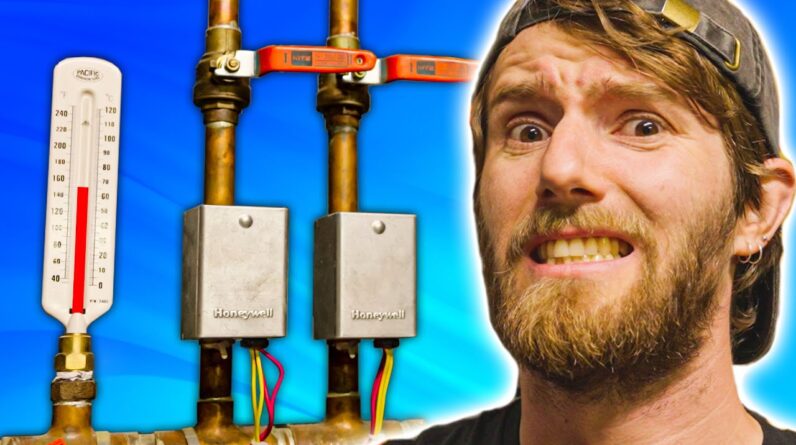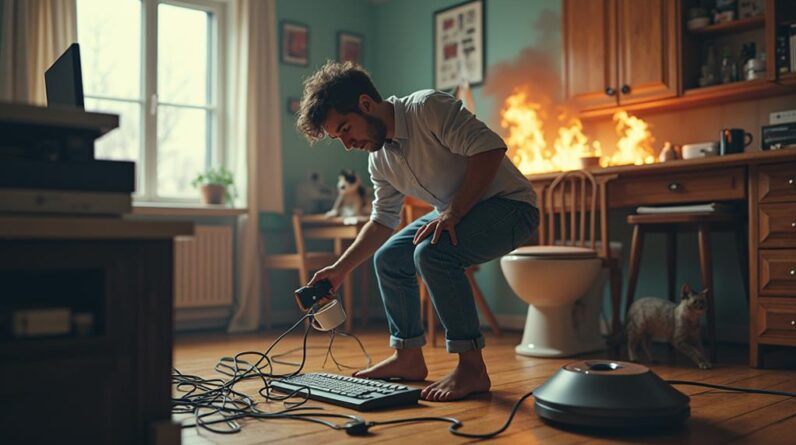
– Oh! It's awesome! – That's so cool. – We can tell exactly where they go. One of the coolest
things about my new house is the heating system. It takes hot water from this boiler and pumps it through the floors, using this bank of valves to decide which rooms are going to get
heating at any given time. And compared to a traditional
forced air system, a hydronic one like this is more efficient and it's completely silent, but the cooling is
another matter altogether.
This puppy right here, who I nicknamed Bryant is grody as heck, 25 years old, and uses only a single temperature probe on the inside of the house to determine whether he turns on or not. That means whoever's hanging out in this north-facing bedroom,
right next to the thermostat, is having a pretty good time. While people sitting in the living room are going to need the fire to warm up. Meanwhile, down in the land center, with all these computers. (whines) Now I could solve these
problems by paying someone to come and install an
expensive multi-zone air conditioning system, but this is Linus (beep)ing Tech Tips. So instead I'm going to
be using a raspberry PI and a handful of these super cool, electronically-controlled dampers that you can get online
for, like, 150 bucks. That's right. Fraction of the cost. And it's going to be way better. – [Jake] Probably not. – But what is better
is shopping with Honey. Honey is the free-to-use shopping tool, that helps search for some
of the best promo codes on tons of your favorite sites.
Get it today and join honey.com/ltt. Before we can determine where to install our cheap AC zone controls, we need to know where the
in-floor heating zones are, because the last thing
in the world we want is for the AC to be
fighting against the heat with both of them
running at the same time, because the freaking zones don't line up. So we're starting here,
in the master bathroom, where the plan is actually to eliminate one of the in-floor heating zones. You can see we've actually got
easy access to show you guys how these in-floor, radiant,
heating tubes are coiled around the room so that your
toes are nice and toasty. It's actually, apparently, pretty common to have a separate in-floor heating zone for the master bathroom, because it's pretty typical
for the flooring type to be different in the bathroom
compared to in the bedroom.
But Yvonne and I are going to be putting the same type of flooring in these rooms. So there's a couple of good
reasons to consolidate. Number one is that the
thermostat for the bathroom sits right here, next
to the duct for the AC. So it would be easy, for that thermostat over on the other wall to be calling for cool, while this one is getting
blasted with cold air, calling for heat. Number two is that
implementing these AC zones is inherently more
expensive and complicated than implementing these heating zones, now that the tubes are
already on the floor, so we're saving ourselves
some "complicatedness" there. Fortunately, the builders did a great job of labeling everything. So I know exactly where all
of these cooling loops run. That means we can focus our attention on how to turn that basic, single zone AC into a multi zone one, and for that, we will be using this,
or something like it.
This is a Honeywell TrueZONE Damper. And what it does is, it's basically, just a piece of ducting that
allows air to flow, or… does not, depending on whether the room is calling for cool or not. To do that, it uses this
24 volt AC actuator, which is designed to be used
with Honeywell's own system, but we found that it works just
fine with anything you want. I love how the readout is just mechanical. So that's how we're going
to do the main floor and the upstairs. But for the basement, we've got both, more possibilities and
some more challenges. The original owners that didn't
finish the entire basement. So they only put two zones down here, one for the bathroom and the rec room, which is where we're standing. These were the finished parts, and the wall actually ended right here, and a second zone for everything else. But I'm gonna show you something cool. Okay, let's go, quick! Before it fires. Right here in the floor– Oh, there it goes. Just kicked in. Right here on the floor, we've got six loops for that "other zone".
And there are actually labels on these, but they are completely
illegible and mean nothing to me. So what we're going to do, is we're going to whip
out the thermal camera and we're going to do a
trace with the hot water that's circulating through the floor to figure out whether we can segment out, say, the land room and the
theater room, for example, which are rooms that could have very different cooling requirements. Yeah, it's going to take a
while to heat up that water. We might want to get some lunch. You guys might have noticed a wild Jake appearing in the background
of the video today. He's here to show us how
this is going to work.
Hit me. – [David] We told you.
– Oh, I just showed up. I didn't know I had to do stuff. So once we actually get
to the final install, when Linus has his server rack going, and his home server, we'll just run Home Assistant in a Docker container
on his unright server. But for now Raz PI is our stand-in. – But assistant doesn't work by magic, so, first things first, we need to figure out
how to close the damper. And the answer is this
24 volt power supply. Wow, it wasn't that convenient. For our demonstration, I
will be the lovely assistant, plugging the AC power
supply into the wall.
– Oh, did you already plug it in? – Yeah, it's plugged in.
– Oh, we're live wires. Here, you want to see some sparks? – No, no, no, no, no, not necessary. – Oh, sparks! (yells) – [Linus] Okay, there's like, kind of– You're gassy. – Can you unplug that actually? – [Linus] Yes.
– Now, when I went in and actually picked this thing up, we were going in totally blind.
I actually had no idea if
this was just going to work. This could have been some
weird proprietary crap that Honeywell requires
you to, like, wire up in a certain way, with
a special power supply. But, fortunately, it's just 24 volt AC. So we plug it in, and we plug it in, and you plug it in.
– Time for the big test. Put your hand in there. I'm not putting my hand in there. – Okay, you be ready?
– I'm ready. – Oh, it's moving, isn't it?
– Oh yeah. – Nice. – I think the closing time
on this thing is 30 seconds. – Okay. – But–
– That makes sense, you don't want to have, like, a sudden shock to the system. It flips closed and there's
all this back pressure. – Yeah, it's just like when you shut your hose really fast, you might hear a (thud),
which is called water hammer. So I guess this would
be like "air hammer"? – Air hammer? Of course, we have to be able to– I can't just stand here.
And go like this, to
control the AC in my house. Surely, we can do you're better than that. – Well, I mean, we could, we could hire a few Linus'. And that's where this guy comes in. Now, what we're going to
use in the final install is not necessarily
going to look like this. It's going to have a lot more channels, but this is what we had laying around and it's going to be
perfect for our demo here. This is what's known as
a "smart relay board". Basically, each one of these is kind of like a light switch. Rather than having a human, or a Linus, in this instance, actuate it, it has a wifi connection that can actually actuate it, instead. Just like clicking these buttons would. And the nice part is, we can integrate this
directly into Home Assistant. So Home Assistant can go, "I want to open that damper." Click that button, power goes
through, opens that damper. – It's been about 20 minutes. It's time– Oh! – [Jake] Oh!
– [Linus] It's awesome! This is fricking awesome.
– It's so cool.
We can tell exactly where they go! Oh my God, this is amazing! – It's almost like it was
made for this purpose. – I love it. So there it is. We've got four lines
into the theater room. Two of them carrying hot water in, two of them carrying cool water out. So you can see there's this clear line dividing the theater room lines from… Go. Oh, here we go. It goes out here. So this room has four as well, then. 1, 2, 3, 4. Oh, shoot. I got prematurely– I think my hopes are dashed. Yeah, it's– I think it's four lines. I don't know what's going on. I think they really did
just kind of YOLO it. The bad news is that the zones overlap. – Yeah, yeah.
– A fair bit. The good news is, that it seems like, for the theater room at least, there's one coil that
does most of the heating. So, if you look here, this boy comes in and
actually crosses over one of the other tubes at the end there. You see that?
– Yeah. So it comes in, it comes down here, and is actually, predominantly, for this room that we're standing in.
Meanwhile, this other one here, this guy right here, goes all the way along the whole floor. So it's only that one edge of the room that would get any heating
from this room's zone. So we could probably get away with it. – Yeah.
– 'cause it wouldn't heat that room very much. – And the main coil–
– I think it's… negligible enough. And,
plus, it would shut off once this room is heated, so I think it's okay.
– Exactly. Yeah. – So now you just have to
give this to the plumbing guys and see if they can figure it out. – Yeah.
– Yeah. – Nice! – Good luck, plumbing guys. – Did we show the wiring for this? – [Jake] No, we didn't.
– Okay. So, very simple. Same 24 volt power supply, well, transformer, really,
'cause it's AC to AC, and then we're going
into the actuator here. The only difference is that we've got our little
wifi relay in the line. You guys might actually
remember this thing from when I "smartefied" my garage door. So, super straightforward, Jake, through Home
Assistant, press the button.

Beautiful. You can see it activates here. The damper opens. Freaking awesome. Except these things,
honestly, aren't that great. I ended up breaking mine, because it turns out there is no hardware way to factory reset it. You have to tell it through
software to factory reset, which is the stupidest thing ever, because if you change your
wifi, blah, blah, blah– The point is, it's
bricked. These things suck. So we're going to be using a bigger one that runs Tasmota firmware,
which is way better. – So, the reason we have this set up to close by default when this is off, it's just so, when we're
like programming it, Home Assistant, it makes
a little more sense for that relay to be
"on" when it is doing air and "off" when it is closed.
So it's "off", it's closing. It's just like a brain logic thing. – Yeah.
– Because, regardless, when this is closed, it uses power. So, whatever. – Of course, it's still
a human pressing buttons. We're getting to that. Now, the most obvious
substitute for a human finger would be a thermostat, but we've got a couple of problems. – First and foremost, having 10 thermostats control the same AC doesn't really work. And on top of that, how is that going to control a damper? – I mean, look at it. This is some ancient technology. It's kind of beautiful. There's only two wires
going to this thing, which go to a 24 volt power supply, back in the mechanical room, that controls the valve for
that particular heating zone.
So, what that means is, basically, this physical-ass,
freaking mercury, either tips and completes
the 24 volt circuit, opening the valve, or it doesn't touch the metal contact, and the valve closes. That's it. Most smart thermostats,
actually a lot of them, don't even work on three wire, let alone on two wire. Screwdriver's not for
sale in the store yet, so buy a shirt, LTTstore.com. Oh, that's awesome. Thankfully, you guys were
full of lots of good ideas in the comments on my last
video about the new house. There were some really
awful ideas, as well. – Terrible ones. – But there were some good ones. One way we could tackle this
is running more conductors, but, unfortunately, that
would require ripping up, not just walls, but in some cases, even flooring of the
house, in order to do that.
That is not happening. – There's 10 of these.
– Yeah. But there were some other ideas as well. One, was to just run
temperature sensors in the rooms and then have everything
controlled via Home Assistant. The problem with that idea
was that the wife and the kids want a bit more of a
user-friendly way of interfacing with the heat and cooling
controls in each room. One suggestion we got, a bunch of times, was to use a thermostat
from someone like tekmar, that just uses these for power, and then communicates
wirelessly back to what is, kind of, the "real" thermostat, back in the mechanical room that has multiple wires
for heating, fan, and AC. The problem with that is then I'm buying into someone's, like,
stupid proprietary thing, and I'm adding a bunch
more complexity that, honestly, isn't necessary. Thank you for the suggestion, though.
That was not one of
the stupid suggestions. – And the solution, well, it turns out it's a
smart thermostat anyways. What we actually ended up with is an Ecobee3 Lite. And this was almost totally by accident. We have these installed at the office, and I was just kind of
checking it for reference. It turns out these guys
are HomeKit enabled, which means we can have
direct connection to them, no cloud necessary, which
was one of your pre-recs. – That was a big thing for me. I don't want to wait for a relay.
And if some stupid cloud service is down, I don't want to not be
able to control the (beep). – Or have no AC at all, right?
– Yeah. – So you plug this guy in, it's basically just got
the two wires for power, which right now is hooked up to this guy. – Yeah.
– But in the future, will be directly wired
through this existing wiring. Plug it in, turns right on. Now the really nice thing
about these ecobees, is, notice we only have two wires connected, but in here, it thinks it has six. – We can just lie to it. – You can literally go in and tell it, "That wire's connected,
that wire's connected, that one's connected,
that one's connected." So this thing thinks it's
directly connected to an AC, directly connected to a fan, and directly connected to a boiler.
But it's not at all. This way, we get the full brain, sort of, smart sensing, smart "run-up", smart rundown of this thermostat. And then we just take what it wants to do. Like, say, it's too hot in here. I want to cool off. It's going to turn into cooling mode, and then we can read
that in Home Assistant. Home Assistant is like, "Whoa, this thing's in cooling mode now. Let me turn on the AC
and open that valve." – Before we can do the big demo, we need to do a couple of things, starting with hooking up, well, some of the multiple aspects of the heating and cooling system. So you can see we've got our AC zone 1. That's our damper. We've got our heat zone 1. So that's going to hook up to the… valve on the boiler. We've got our AC power. That's going to tell it
to turn on the compressor. And then of course
we've got our fan power, which is going to tell the air conditioner to blow cool air around the house.
So, right now, for the
purposes of our demo, we've just got AC and fan. Then, in Home Assistant, Jake has been setting up automations, which are effectively scripts that allow all of these elements to interact with each other, because the last thing you want is to kick on your fan
and your compressor, but then have your damper closed, because then you're going to create a bunch of back pressure, potentially blowing up
your air conditioner.
So, what we've done, is we've made sure that as long as one AC zone is calling for an open damper, the AC power and the fan will go on, and, if all of these are closed, these will turn off. So, this is it then. Exactly how we want this to work, with the thermostat on the wall, someone could set a temperature
hold, and then, okay. At 11:30, when the normal rules take over, normal scheduling,
everything's just totally transparent to the user, we end it. And… our AC should kick on. Look at that! The fan goes, the damper opens, 'cause remember, "on" is
"off" for the damper, right? So it's open and we're blowing.
And then if I say, "Okay, look, I really don't need that much cooling 'cause I'm a hot boy." Look at that. It's fricking awesome. Look at it go. The application for stuff like this is really exciting, and basically endless, with just simple sensors
that could be wall-powered or even battery-powered,
you can do almost anything. You could sit down in your computer chair and have a battery-powered pressure sensor that turns on a freaking desk fan.
The way that I plan to use this is really to amp up the
efficiency in this place. So every wall light switch is going to have a motion sensor in it, which means that I'm going
to have occupancy awareness. So the AC will never turn on in a room that hasn't had anyone in it for the last, let's say, 30 or 60 minutes,
or something like that. It'll pretty much pay for itself. It'll just take a few years. It's really exciting. Almost as exciting as telling
you about our sponsor. Privacy lets you shop online
with virtual credit cards that offer way more security and control than conventional cards. Like, if you ever signed
up for a free trial and then forgotten about it, only to find the charges on your statement for a subscription that
you never actually wanted, like, a year later, with Privacy, all you have to do is create an individual card just for that trial.
You designate the card to be single use, set the monthly spending limit to $1. So companies actually cannot
charge you, even if you forget. Privacy.com is PCI DSS compliant, is encrypted to secure your information, and offers two-factor authentication. And since they make money from merchants, there's no cost to you. So sign up today and
you'll get $5 for free, at privacy.com/Linus. That's privacy.com/Linus. If you guys enjoyed this video, but you have no idea what
the heck was going on. Maybe check out part 1, where I, kind of, show you
guys around the new house and talk about this and
some of the other challenges that we're going to be trying to solve over the next few months.
As an Amazon Associate I earn from qualifying purchases.







